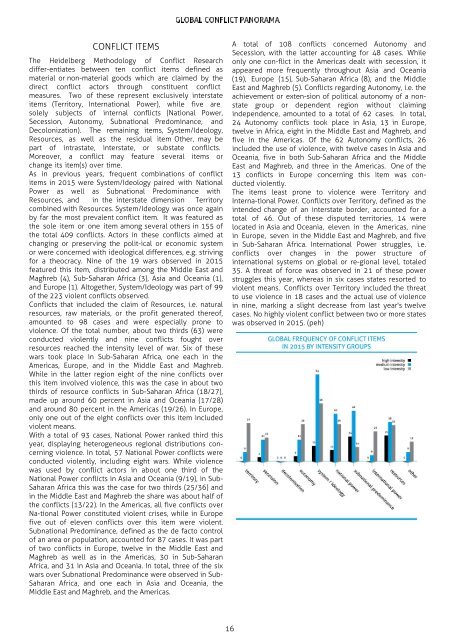ConflictBarometer_2015
ConflictBarometer_2015
ConflictBarometer_2015
Create successful ePaper yourself
Turn your PDF publications into a flip-book with our unique Google optimized e-Paper software.
GLOBAL CONFLICT PANORAMA<br />
CONFLICT ITEMS<br />
The Heidelberg Methodology of Conflict Research<br />
differ-entiates between ten conflict items defined as<br />
material or non-material goods which are claimed by the<br />
direct conflict actors through constituent conflict<br />
measures. Two of these represent exclusively interstate<br />
items (Territory, International Power), while five are<br />
solely subjects of internal conflicts (National Power,<br />
Secession, Autonomy, Subnational Predominance, and<br />
Decolonization). The remaining items, System/Ideology,<br />
Resources, as well as the residual item Other, may be<br />
part of intrastate, interstate, or substate conflicts.<br />
Moreover, a conflict may feature several items or<br />
change its item(s) over time.<br />
As in previous years, frequent combinations of conflict<br />
items in <strong>2015</strong> were System/Ideology paired with National<br />
Power as well as Subnational Predominance with<br />
Resources, and in the interstate dimension Territory<br />
combined with Resources. System/Ideology was once again<br />
by far the most prevalent conflict item. It was featured as<br />
the sole item or one item among several others in 155 of<br />
the total 409 conflicts. Actors in these conflicts aimed at<br />
changing or preserving the polit-ical or economic system<br />
or were concerned with ideological differences, e.g. striving<br />
for a theocracy. Nine of the 19 wars observed in <strong>2015</strong><br />
featured this item, distributed among the Middle East and<br />
Maghreb (4), Sub-Saharan Africa (3), Asia and Oceania (1),<br />
and Europe (1). Altogether, System/Ideology was part of 99<br />
of the 223 violent conflicts observed.<br />
Conflicts that included the claim of Resources, i.e. natural<br />
resources, raw materials, or the profit generated thereof,<br />
amounted to 98 cases and were especially prone to<br />
violence. Of the total number, about two thirds (63) were<br />
conducted violently and nine conflicts fought over<br />
resources reached the intensity level of war. Six of these<br />
wars took place in Sub-Saharan Africa, one each in the<br />
Americas, Europe, and in the Middle East and Maghreb.<br />
While in the latter region eight of the nine conflicts over<br />
this item involved violence, this was the case in about two<br />
thirds of resource conflicts in Sub-Saharan Africa (18/27),<br />
made up around 60 percent in Asia and Oceania (17/28)<br />
and around 80 percent in the Americas (19/26). In Europe,<br />
only one out of the eight conflicts over this item included<br />
violent means.<br />
With a total of 93 cases, National Power ranked third this<br />
year, displaying heterogeneous regional distributions concerning<br />
violence. In total, 57 National Power conflicts were<br />
conducted violently, including eight wars. While violence<br />
was used by conflict actors in about one third of the<br />
National Power conflicts in Asia and Oceania (9/19), in Sub-<br />
Saharan Africa this was the case for two thirds (25/36) and<br />
in the Middle East and Maghreb the share was about half of<br />
the conflicts (13/22). In the Americas, all five conflicts over<br />
Na-tional Power constituted violent crises, while in Europe<br />
five out of eleven conflicts over this item were violent.<br />
Subnational Predominance, defined as the de facto control<br />
of an area or population, accounted for 87 cases. It was part<br />
of two conflicts in Europe, twelve in the Middle East and<br />
Maghreb as well as in the Americas, 30 in Sub-Saharan<br />
Africa, and 31 in Asia and Oceania. In total, three of the six<br />
wars over Subnational Predominance were observed in Sub-<br />
Saharan Africa, and one each in Asia and Oceania, the<br />
Middle East and Maghreb, and the Americas.<br />
A total of 108 conflicts concerned Autonomy and<br />
Secession, with the latter accounting for 48 cases. While<br />
only one con-flict in the Americas dealt with secession, it<br />
appeared more frequently throughout Asia and Oceania<br />
(19), Europe (15), Sub-Saharan Africa (8), and the Middle<br />
East and Maghreb (5). Conflicts regarding Autonomy, i.e. the<br />
achievement or exten-sion of political autonomy of a nonstate<br />
group or dependent region without claiming<br />
independence, amounted to a total of 62 cases. In total,<br />
24 Autonomy conflicts took place in Asia, 13 in Europe,<br />
twelve in Africa, eight in the Middle East and Maghreb, and<br />
five in the Americas. Of the 62 Autonomy conflicts, 26<br />
included the use of violence, with twelve cases in Asia and<br />
Oceania, five in both Sub-Saharan Africa and the Middle<br />
East and Maghreb, and three in the Americas. One of the<br />
13 conflicts in Europe concerning this item was conducted<br />
violently.<br />
The items least prone to violence were Territory and<br />
Interna-tional Power. Conflicts over Territory, defined as the<br />
intended change of an interstate border, accounted for a<br />
total of 46. Out of these disputed territories, 14 were<br />
located in Asia and Oceania, eleven in the Americas, nine<br />
in Europe, seven in the Middle East and Maghreb, and five<br />
in Sub-Saharan Africa. International Power struggles, i.e.<br />
conflicts over changes in the power structure of<br />
international systems on global or re-gional level, totaled<br />
35. A threat of force was observed in 21 of these power<br />
struggles this year, whereas in six cases states resorted to<br />
violent means. Conflicts over Territory included the threat<br />
to use violence in 18 cases and the actual use of violence<br />
in nine, marking a slight decrease from last year's twelve<br />
cases. No highly violent conflict between two or more states<br />
was observed in <strong>2015</strong>. (peh)<br />
16


